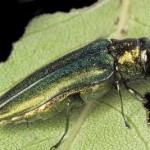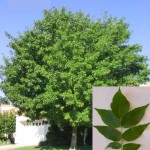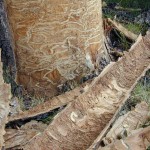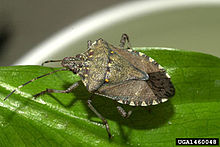The emerald ash borer, Agrilus planipennis Fairmaire, a beetle native to Asia, was first detected in Michigan in 2002. Evidence suggests that the beetle was established in Michigan for years prior to its discovery. Emerald ash borer (EAB) has since been detected in several states including Pennsylvania. In addition to spreading by natural means, EAB can be transported to new areas in infested firewood, timber, and nursery stock. This beetle has been responsible for the loss of millions of ash trees in North America.
Host: In North America, EAB is known to infest all species of ash. Ash can be recognized by the presence of compound leaves which are arranged opposite of one another on the branches.
Biology: Eggs are laid between layers of bark and in bark crevices. Larvae hatch in about one week and bore into the tree where they feed on the inner bark and phloem, creating “S” -shaped galleries. Larvae go through three feeding stages, and then excavate a pupal chamber in the fall, where they will overwinter as prepupae. Pupation occurs in late spring, and adults begin to emerge through “D” shared exit holes in May and early June. Adults will remain active until the end of summer.
Symptoms and Signs: New infestations are difficult to detect, as damage to the tree may not be apparent for up to three years. Symptoms in the upper crown, excessive epicormic branching on the tree trunk, and vertical bark slits. Woodpecker damage is sometimes apparent.
Protecting our Forests and Trees in Pennsylvania:
- Use Local Firewood.
- Do not bring firewood into PA. This is banned under order of quarantine currently.
- If you have already transported firewood, do not take it home, do not leave it – BURN IT.
Reporting Ash Borer Beetle to PA Department of Agriculture:
The PA Department of Agriculture is scheduling spray treatments for the beetle. If you discover or think you have found the Emerald Ash Borer, report it by contacting:
PA Department of Agriculture: 1-866-253-7189 or report your sighting by e-mail at: Badbug@state.pa.us
This information is directly from the Penn State Cooperative Extension. Please consult at: http://www.paemeraldashborer.psu.edu



